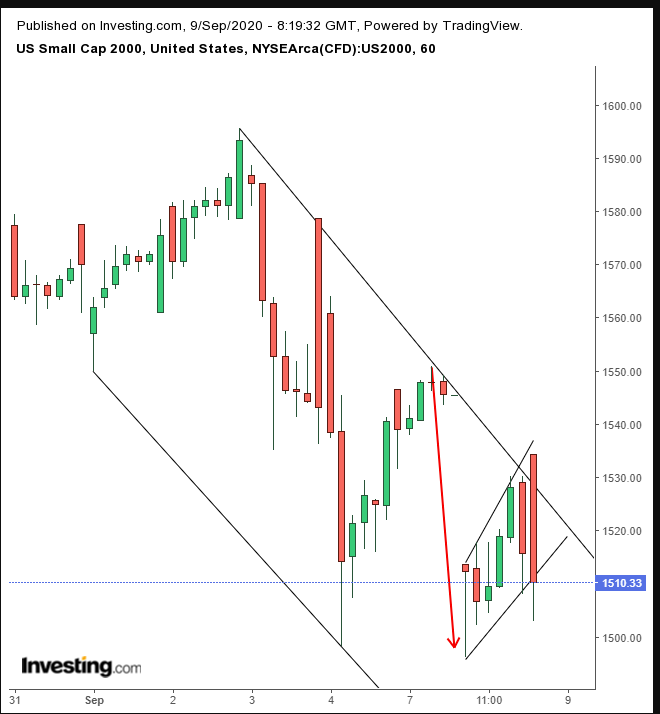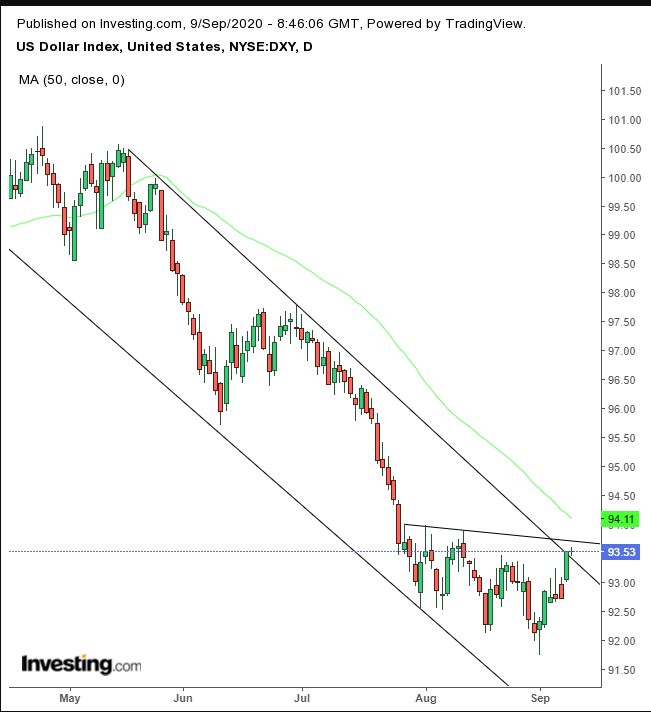- AstraZeneca recovers from selloff after putting its COVID vaccine trial on hold
- Markets shrug off vaccine setback
- Oil finds footing after shedding 15% of value
Key Events
US futures, including the Dow, S&P 500 and NASDAQ, and European stocks were higher on Wednesday, despite news that AstraZeneca (LON:AZN) has halted its COVID vaccine trials.
The dollar rally persisted and gold wavered. Oil recovered.
Global Financial Affairs
The fact that traders took the vaccine news in their stride could be considered a double-edged sword. It might be an impressive show of the market's strength due to the belief that the unprecedented fiscal and monetary policies we are witnessing will help economies shake off the devastation of the pandemic.
Or it might underpin the view that investors are starry eyed and consider every market dip a buying opportunity.
The coronavirus pandemic lockdown caused the fastest bear market on record and the worst recession since the Great Depression. Without a solution to it, we can’t expect the economy to return to pre-COVID levels. So, why are investors so cool about this delay?
Is it because they think the odds are favorable that we will have a vaccine soon, as there are so many ongoing trials competing to be successful. Or is it because the market no longer cares and traders know we are in a bubble and are operating under the Greater Fool Theory—buy an overvalued asset because you expect it to go higher, and then sell it for a profit to the next guy.
Whatever the reason, shares of the UK drugmaker fell 3% on the news, but quickly pared losses in London trading to just 1.3%. The vaccine, which was developed with Oxford University, was considered to be one of the world's leading candidates and at the most advanced stage of development.
Notwithstanding, we remain bullish on equity markets and stand by our Sunday post for as long as the newly established uptrend remains. But we're keeping a finger on the pulse.
Meanwhile, this morning, three of the four major US contracts have been testing the tops of hourly rising flags, bearish after preceding drops—as well as developing beneath the top of their respective hourly falling channels.
Contracts on the Russell 2000 are ahead of the pattern development, already testing the bottom of its flag, threatening to complete the bearish pattern.

In Europe, investors braved loftier precipices, driving the Stoxx Europe 600 higher after a lower open, whose falling gap was filled inside two minutes. The pan-European index has been climbing since.

European stocks, like US futures, were showing resilience amid broad selloffs provoked by overvalued tech shares.
In the US, stocks sunk to a 4-week low on Tuesday as the tech rout deepened. The NASDAQ 100 shed 4.8% of its value, ending 11% below its recent string of records.
Tesla (NASDAQ:TSLA) experienced its worst selloff in the company's history, leaving it down 34% since Sept. 1. Apple (NASDAQ:AAPL) plummeted 6.9%, erasing nearly $140 billion in market value on its third day of declines. Overall losses during its three-day drop were 14%, its worst slump since October 2008.
Volatility also returned to markets which, until recently have enjoyed a golden period of smooth rallies, including a series of records, as investors benefited from the best of both worlds: improving economic data and continued stimulus.
While investors might have feared a bubble like that of the dot-com era—and our earlier cautionary comments notwithstanding—there is a major difference between the market today and 12 years ago.
The dot-com bubble was based on investor expectations that technology stocks would continue to go up in a straight line, while today’s unrealistic expectations have the approval of the Fed, the institution whose mandate is to maintain economic stability.
The S&P rout pulled prices below the most recent uptrend line.

Will bulls step up and push higher, drawing a new uptrend line, or will this be the last one? After the most recent, exuberant rally, prices will have to fall below 3,000 before we'd consider it a reversal.
While yesterday's gains in yields, including for the 10-year Treasury note, were nearly wiped out by today’s drop, the movement still extended the H&S top pattern.

The dollar continued to surprise, with its persistent rally, as investors fled to Treasuries amid the worst equity selloff in months.

The USD is testing the top of a falling channel. If it breaks the trendline tracking its highest prices since August, we'll consider calling it a short-term bottom.
Gold has been fluctuating wildly over the last four sessions.

It is testing the bottom of both a bullish pennant and the bottom of its rising channel, buttressed by the 50 DMA.
Oil edged lower after its biggest one-day drop in more than two months on Tuesday, as growing doubts over the strength of the global demand recovery along with continued weakness in stocks soured market sentiment.

WTI appeared to have found its footing after a five straight day loss, bringing the price down by more than 15%, 5% away from an official bear market. The commodity completed a rising wedge, bearish after the explosive rally.
Up Ahead
- The ECB is expected to hold rates steady on Thursday, but indicate that downside risks have intensified, suggesting further easing is possible before year-end.
- The US releases initial jobless claims numbers Thursday.
- US CPI data is due Friday, with consumer prices expected to have risen in August.
Market Moves
Stocks
- Futures on the S&P 500 Index increased 0.1% as of 8:07.
- The Stoxx Europe 600 Index climbed 0.1%.
- Germany’s DAX Index gained 0.3%.
- The MSCI Asia Pacific Index fell 1.1%.
Currencies
- The Dollar Index was little changed at 93.53.
- The euro decreased 0.1% to $1.1769.
- The Japanese yen strengthened 0.1% to 105.88 per dollar.
- The British pound fell 0.4% to $1.293.
Bonds
- The yield on 10-year Treasuries declined two basis points to 0.66%.
- Germany’s 10-year yield decreased one basis point to -0.50%.
- Britain’s 10-year yield dipped two basis points to 0.173%.
Commodities
- West Texas Intermediate crude declined 0.8% to $36.45 a barrel.
- Gold weakened 0.3% to $1,926.75 an ounce.
